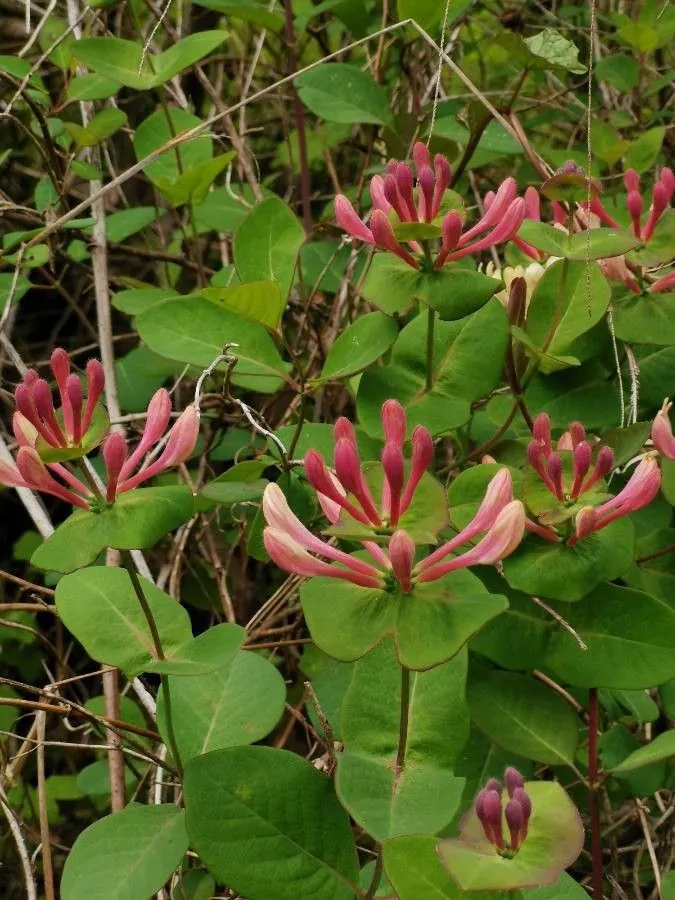
Author: L.
Bibliography: Sp. Pl.: 173 (1753)
Year: 1753
Status: accepted
Rank: species
Genus: Lonicera
Vegetable: Unknown
Observations: C. & SE. Europe to Caucasus
Perfoliate honeysuckle, scientifically known as Lonicera caprifolium, is a flowering plant belonging to the family Caprifoliaceae. Introduced to the world in 1753 by the botanist Carl Linnaeus, whose work is cited in “Species Plantarum” on page 173, this species has a rich history and distinctive characteristics that make it noteworthy among gardeners and botanists alike.
Native to Central and Southeastern Europe and extending to the Caucasus region, perfoliate honeysuckle thrives in various climates within these geographical bounds. This robust, deciduous climber is known for its twining stems that can elegantly cover trellises, walls, or fences, making it highly valued for ornamental purposes.
One of the most captivating features of Lonicera caprifolium is its foliage. The plant’s leaves are distinctive, being arranged in pairs to form a disk-like structure that completely encircles the stem — a unique trait referred to as “perfoliation.” This adaptation not only contributes to its common name but also adds a striking visual appeal when the plant is in full bloom.
The flowers of perfoliate honeysuckle are another highlight. Usually appearing from late spring to early summer, these tubular blossoms exhibit a creamy white hue that matures into yellowish tones as they age. They are not only aesthetically pleasing but also intensely fragrant, releasing a sweet scent that can perfume the air, especially in the evening. This fragrance attracts a variety of pollinators including bees, butterflies, and moths.
Following the flowering period, the plant produces small, reddish-orange berries that add a splash of color into the autumn months. While these berries are attractive, it’s worth noting that they are not considered edible for humans and should be handled with care, especially around children and pets.
In terms of cultivation, Lonicera caprifolium is relatively undemanding. It can thrive in both full sun and partial shade, although it prefers well-drained soils. Regular watering and occasional pruning can help maintain its shape and encourage more prolific flowering.
In conclusion, perfoliate honeysuckle is a cherished member of the Caprifoliaceae family, admired for its unique leaf formation, fragrant blooms, and ornamental value. Its ability to adapt and thrive across various regions in Central and Southeastern Europe to the Caucasus makes it a versatile addition to gardens and landscapes.
Lit: apskritalapis sausmedis
Fra: chèvrefeuille commun, chèvrefeuille des jardins, clématite des jardins
Swe: dansk iris, höstkrokus, kammynta, kaprifol, trädgårdskaprifol, tuoksuköynnöskuusama, äkta kaprifol
Deu: echtes geißblatt, jelängerjelieber, wohlriechendes geißblatt
Eng: italian honeysuckle, italian woodbine, perfoliate honeysuckle, goat-leaved honeysuckle
Pol: wiciokrzew przewiercień
Nno: kaprifol
Nob: kaprifol
Est: lõhnav kuslapuu
Lav: sausserdis
Fin: tuoksuköynnöskuusama
Ces: zimolez kozí list
Dan: ægte kaprifolie, ægte kryddermynte
Nld: tuinkamperfoelie
Cym: gwyddfid trydwll
En: Perfoliate honeysuckle, Italian honeysuckle, Italian woodbine, Honeysuckle, Goat-leaved honeysuckle, Caprifoyle, Smaller Honeysuckle
Ar: عسلة معزية الأوراق
Hy: Այծացախակեռաս
Az: Kaprifol
Be: Капрыфоль
Ca: Xuclamel
Hr: Prava kozokrvina
Cs: Zimolez kozí list, Zimolez zahradní
Da: Ægte Kaprifolie, Ægte kryddermynte
Nl: Tuinkamperfoelie, Gewone Kamperfoelie
Et: Lõhnav kuslapuu
Fi: Tuoksuköynnöskuusama
Fr: Clématite des jardins, Chèvrefeuille des Jardins, Chèvrefeuille commun
Ka: Ჯიქა
De: Wohlriechendes Geißblatt, Jelängerjelieber, Echtes Geißblatt, Gartengeißblatt, Garten-Geißblatt
Hu: Jerikói lonc
It: Abbracciabosco, Caprifoglio (Madreselva) comune, Legabosco, Manicciola, Uva di San Giovanni, Caprifoglio comune, Madreselva comune
Lv: Smaržīgais sausserdis, Sausserdis
Lt: Apskritalapis sausmedis
No: Kaprifol
Nb: Kaprifol
Nn: Kaprifol
Fa: پیچ امینالدوله
Pl: Wiciokrzew przewiercień
Ru: Каприфоль
Sr: Орлови нокти
Es: Madreselva, Kovačnik, Madreselva de los Jardines, Madreselva común
Sv: Kaprifol, Äkta kaprifol, Dansk iris, Höstkrokus, Kammynta, Trädgårdskaprifol, Tuoksuköynnöskuusama
Uk: Жимолость запашна
Cy: Gwyddfid trydwll
Taken Apr 24, 2017 by Cruz Fer (cc-by-sa)
Taken Apr 24, 2017 by Cruz Fer (cc-by-sa)
Taken Jun 16, 2020 by hadrien gaudin-hamama (cc-by-sa)
Taken May 27, 2020 by Valerie Bailey (cc-by-sa)
Taken Apr 11, 2020 by Preobrazhenski Serj (cc-by-sa)
Taken Oct 5, 2019 by Isabelle EYMARD (cc-by-sa)
Taken Jun 10, 2021 by Emanuele Santarelli (cc-by-sa)
Taken Jun 17, 2020 by linn onepower (cc-by-sa)
Taken Apr 24, 2021 by Pietro Brignoli (cc-by-sa)
Taken Apr 24, 2021 by Pietro Brignoli (cc-by-sa)
Taken May 30, 2021 by Maxime Paillat (cc-by-sa)
Taken Jun 16, 2021 by an.art (cc-by-sa)
Taken Sep 14, 2020 by M G (cc-by-sa)
Taken Oct 31, 2022 by Jacques Zuber (cc-by-sa)
Taken May 25, 2021 by Carlo Alfano (cc-by-sa)
Taken Apr 5, 2013 by Tela Botanica − Alexis Joly (cc-by-sa)
Taken Mar 16, 2013 by Tela Botanica − Alexis Joly (cc-by-sa)
Taken Mar 16, 2013 by Tela Botanica − Alexis Joly (cc-by-sa)
Taken Aug 1, 2020 by Rico Mende (cc-by-sa)
Taken Nov 11, 2022 by Blue Tilia (cc-by-sa)
Taken Sep 15, 2021 by Magnus Onu (cc-by-sa)
Taken Sep 8, 2021 by Michael Schneider (cc-by-sa)
Taken Aug 6, 2021 by Margie Pigott (cc-by-sa)
Taken Oct 2, 2021 by michel flet (cc-by-sa)
Taken Oct 31, 2022 by Jacques Zuber (cc-by-sa)
© copyright of the Board of Trustees of the Royal Botanic Gardens, Kew.
© copyright of the Board of Trustees of the Royal Botanic Gardens, Kew.
© copyright of the Board of Trustees of the Royal Botanic Gardens, Kew.
Taken Apr 13, 2022 by Dabronzo Carlo (cc-by-sa)
Taken Aug 1, 2020 by Rico Mende (cc-by-sa)
Taken Jun 13, 2021 by Ludovic Gayet (cc-by-sa)
Taken May 16, 2020 by remie (cc-by-sa)
Taken May 22, 2021 by William Balleton (cc-by-sa)
Family: Myrtaceae Author: (F.Muell.) K.D.Hill & L.A.S.Johnson Bibliography: Telopea 6: 402 (1995) Year: 1995 Status:…
Family: Rubiaceae Author: Pierre ex A.Froehner Bibliography: Notizbl. Bot. Gart. Berlin-Dahlem 1: 237 (1897) Year:…
Family: Sapindaceae Author: Koidz. Bibliography: J. Coll. Sci. Imp. Univ. Tokyo 32(1): 38 (1911) Year:…
Family: Asteraceae Author: A.Gray Bibliography: Pacif. Railr. Rep.: 107 (1857) Year: 1857 Status: accepted Rank:…
Family: Fabaceae Author: Medik. Bibliography: Vorles. Churpfälz. Phys.-Ökon. Ges. 2: 398 (1787) Year: 1787 Status:…
Family: Aspleniaceae Author: (Cav.) Alston Bibliography: Bull. Misc. Inform. Kew 1932: 309 (1932) Year: 1932…